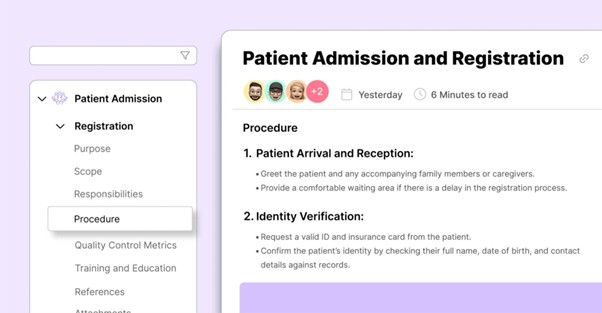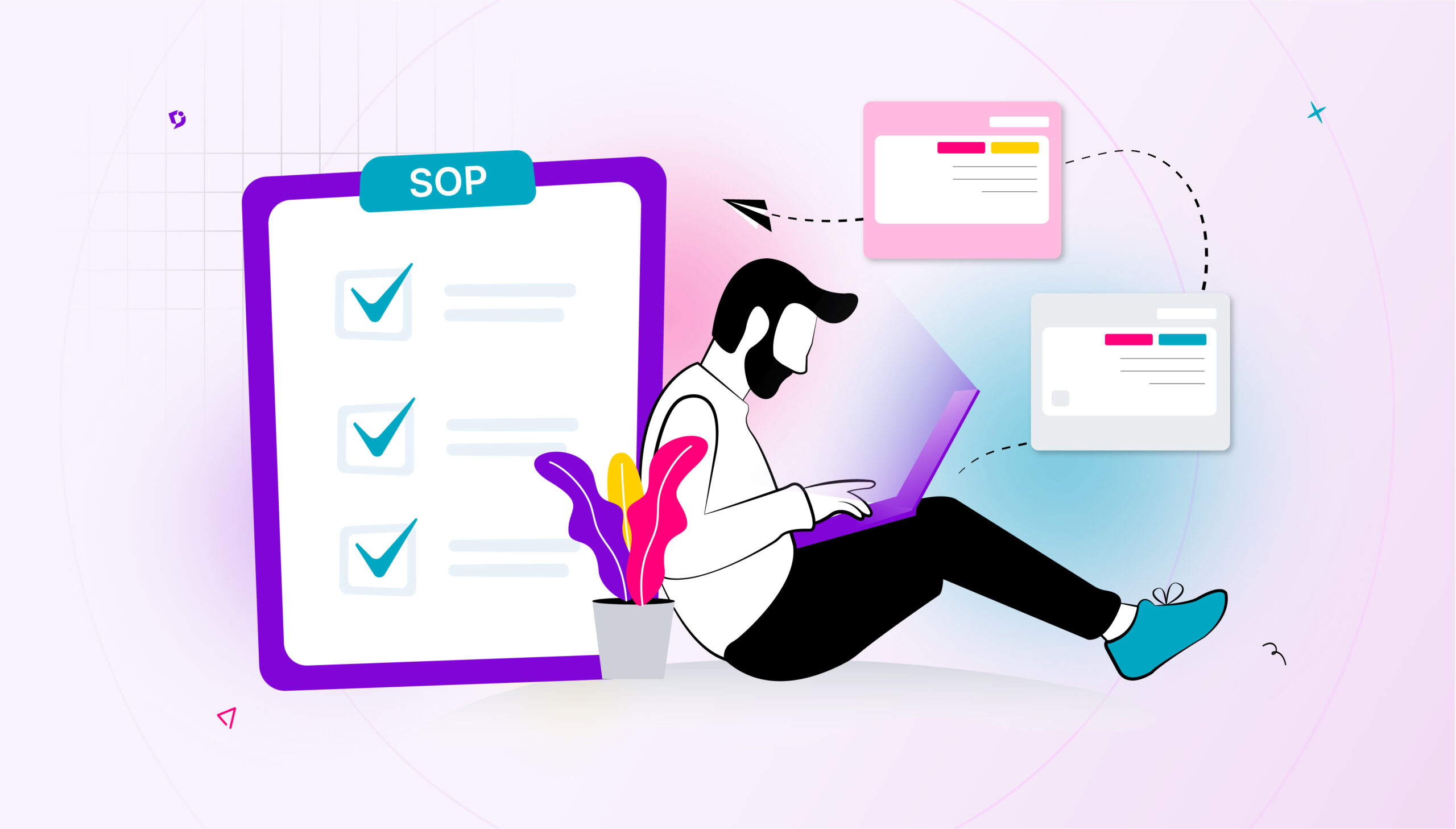Clinical practice is the application of medical knowledge to diagnose and treat patients by healthcare professionals and requires the execution of many day-to-day operations. This could be in a hospital, surgery, or any other healthcare provider. The stakes are high, and patient health, and maybe even their lives, depend on the performance of the healthcare professionals.
In this complex setting, many procedures, from booking in new patients to advanced bookkeeping tasks, need to be performed repeatedly by different employees, such as clerical staff, receptionists, and porters.
It’s important to document these procedures so that medical knowledge can be disseminated throughout the organization. SOPs are the format used in professional settings to document and share procedures for the benefit of employees.
What is a Clinical SOP?
A SOP is a document that documents a particular process or procedure and how to do it. It’s a step-by-step procedure that outlines exactly how to perform a task, referring generally to the member, or members, of staff responsible for the procedure.
The purpose of an SOP is to ensure that employees operate correctly with the right outcome within a clinical setting. The SOP ensures that the procedure is performed the same way, every time so that whoever is following the SOP will achieve the same result.
SOPs are important for documenting any technical, medical, or administrative activity that is repetitive. For example, you might have an SOP for the best way to store patient files. Any procedure can be documented as an SOP as long as it is performed the same way every time.
SOPs are generally not flexible, so they need to be followed rigorously in order to reach the same standards of quality control required by the organization.
Why SOPs Matter in Clinical Practice
Standard operating procedures ensure consistency and quality in clinical practices. Here is a list of benefits of having a well-documented SOP in clinical practices
Ensures Consistency in Clinical Procedures
SOPs can ensure that clinical procedures are consistent since clinicians have a document to follow that means procedures are completed the same way every time. They reduce ambiguity over the process and facilitate uniform outcomes no matter who is completing the SOP. The SOP is broken down into steps that any employee can follow to get the same result, as long as they follow the instructions.
Compliance with Regulations
Many SOPs are related to regulatory compliance, and certain procedures must follow protocol. The SOP ensures this protocol is followed and complies with regulations in your region or country. SOPs enable employees to adhere to clinical guidelines that are set for the safety of staff and patients.
Supports Effective Training of Staff
New and existing staff members can use the SOPs in their training to learn the correct protocols. They can consult the SOPs during their training and learn how the clinical practice operates without constantly asking colleagues for help. SOPs vastly improve onboarding for new staff members and ensure that existing staff can stay informed of relevant guidelines.
Helps in Adhering to Quality control
SOPs achieve quality control by standardizing performance as long as healthcare professionals follow them. As professionals can observe the step-by-step instructions within the SOP, outcomes are more likely to be successful. SOPs also mean that you’ll get the same outcome no matter who performs the procedure.
Key Elements of Clinical SOPs
Now we understand that SOPs are vital tools for ensuring quality, consistency, and compliance in a clinical setting. Here are the Key elements to be included in the SOPs.
Procedure Title and Number
Include the procedure title and number to distinguish your SOP from other documents. This title and number should be unique, and the title should be descriptive of the procedure contained within your SOP.
Versioning and Approval of SOP
Use software that allows you to version your SOP so you can see which version is current and revert to an earlier version if necessary. You can also view changes and compare different versions of your SOP to see which one is correct. Include which version of your SOP you are using in the document.
Purpose, Scope, and Background
Include the purpose, scope, and background of your SOP to explain exactly what is in your document. This section is like a summary of your whole SOP, so employees don’t have to read it to understand what’s in it.
Stakeholders’ Roles and Accountabilities
Include any stakeholders relevant to your SOP and their roles and accountabilities for the procedure. Refer to the stakeholder by their job title and be clear about the role that they play in completing the SOP.
Clinical Term Definitions and Terminology
Use clinical definitions within your SOP so healthcare professionals are using the correct terminology. Correct terms will ensure that your SOP is followed and that there is no ambiguity within it. If a term is unclear, be sure to include a definition.
Amendment History
Include an amendment history, which is a list of changes, for your SOP. This will clarify your SOP and help you understand how it has evolved.
Interested in Document360 AI-Powered Knowledge Base? Schedule a demo with one of our experts
Book A Demo
Steps to Create a SOP for Clinical Practice
Developing an SOP for clinical practice involves identifying the procedure, defining objectives, and breaking it down into clear, actionable steps to ensure consistency and compliance. Here are key steps to create an SOP for clinical practice.
1. Identify Areas Requiring Standardization
The first step is identifying any areas within your clinical practice that need to be standardized, so that means whoever is performing the procedure completes it the same every time. These are actions that are performed over and over again, such as dispensing medication or welcoming new patients. These actions require standardization and can benefit from an SOP that explains how to complete them.
2. Involve Key Stakeholders
Involve key stakeholders, such as clinical staff, quality assurance, and administration, in the writing of your SOP so they can give their input into the procedure. These are the people who will actually be carrying out the SOP, so they should be involved in the production of your documentation.
3. Choose an SOP Documentation Tool for your Clinic
SOP documentation requires the appropriate tool for sharing information, such as Document360. There are all sorts of features you should look for to make creating your SOPs as easy as possible and hosting them online securely for clinical professionals to share.

What to Look for:
Integration with other Clinical systems
SOP documentation is a whole lot easier when your SOP tool integrates with other clinical systems that you use. This means data is shared between your different systems so when using your SOP tool you can have visibility into the data from relevant clinical systems without switching screens.
AI capabilities and SOP Templates for easy documentation
Many SOP tools offer AI capabilities and SOP templates to make documenting your SOPs faster and easier. AI generates the documentation outline for you and tags your articles to make them much simpler to find, as well as suggesting titles and summarizing articles. AI reduces the administrative load on documentation tasks.
Advanced Search Capability
Advanced search capability uses AI to search the SOP tool and find relevant documentation for your users. It is much more powerful than standard search and tolerant of typos, so even if users don’t use the exact search term, they can still find what they are looking for.
Easy learning and Implementation curve
Your SOP tool should be easy to learn and set up, getting you running in minutes. It should not require any technical expertise to use so the focus is on creating content, not grappling with a tool.
Powerful Versioning and Control

You should be able to control the different versions of your SOPs so you can see and switch between the version history of your documents. This feature is essential when making changes and especially supports creating SOPs as a team.
Compliance and Regulatory Support
Your SOP tool should comply with all regulations in your region such as data protection laws, including GDPR and SOC2.
Access permission management

Your SOP tool requires different roles when authoring documentation so access permissions should grant access to admins, editors, and readers. This gives them a different level of permissions when viewing the documentation in the system.
4. Document existing procedures as a baseline
Use existing procedures to document in your SOPs before moving on to new procedures. Look in your organization for repetitive tasks that could use an SOP and create documentation based on the need. Choose your most commonly used procedures as a baseline to document before moving on to more complex ones.
5. Decide on SOP Content Structure
Work out how you will categorize your SOPs in the SOP tool to have some kind of organizational structure. You could choose categories based on the stakeholders for your SOPs or the area of the clinical setting such as administrative tasks. This structure should be intuitive so users can easily browse your SOPs.
6. Expert Review and Pilot Testing
Test your SOPs with a select handful of experts who will be carrying out your SOPs. Conduct a pilot test to check they work as designed and make corrections as necessary if it turns out your SOP is not quite adequate.
7. Staff Training and Implementation
Train your staff on how to use your SOPs, making sure they know where your SOPs are and their purpose. Make it clear that your SOPs will not be relevant to everyone, but find the SOPs that will help them in their clinical work.
8. Ensure SOP Documentation Access to All Relevant Staff
Set up a private knowledge base that gives access to your SOP documentation to everyone with a username and password or only with a certain IP address specific to your organization. This documentation is private so you’ll need to make sure it’s protected from organizational outsiders.
9. Incorporate Changes in Clinical Guidelines
Update your SOPs as clinical guidelines change to ensure they stay relevant and up-to-date. Use version control to create a new version of the SOP that adheres to the new guidelines while keeping the old version accessible.
Also Read: HR SOP: What it is, Types, Benefits & Templates
Wrapping Up
Clinical SOPs are essential for healthcare providers committed to providing smooth day-to-day operations. They standardize operations and maintain quality control in complex, busy environments that must produce positive outcomes every time. Clinical professionals can access these SOPs during their training and in the course of their jobs.
Producing effective SOPs in a clinical setting means you need to be aware of the correct medical terminology and the stakeholders responsible for the procedures. High staff turnover requires the SOPs to be accessible and generalized so that anyone can understand them, even if they are new to their role.
Choosing the right software for your clinical SOPs is essential and this is where Document360 can really shine. It’s easy to use and fully secure for a healthcare setting, so you can create documentation swiftly without worrying about who has access or if your SOPs will be revealed to the world.





 –
– 

